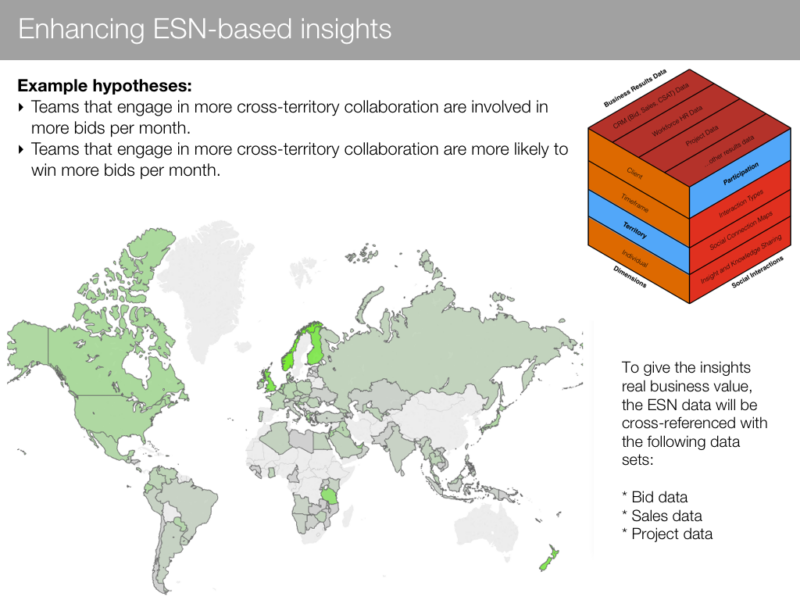By 2017, McKinsey predicts that 70% of companies will have an Enterprise Social Network (ESN). Now that these platforms are finally mainstream, we need to focus on how to increase their utility and usefulness for employees and the wider organisation.
Adoption and engagement remain challenges for many, and we have been working to improve these for over a decade, so we have an extensive library of techniques. But usage is not the same thing as usefulness. We heard this point made last week at two events – smilelondon2016 and the i2 Summit in Zurich. In the workshop that I led in Zurich, the participants responsible for their company’s social platforms admitted their struggle with ESN vanity metrics. Adoption stats like number of profiles and even baseline usage metrics do not tell the full story. For example, Facebook at Work may enjoy a 90% active rate amongst its beta users, but it does not matter how many people use an ESN if the value created is low.
So how do we unlock the potential of enterprise social platforms, and what higher purpose can they support in the organisation?
The ESN as a Base for a Digital Workplace Hub
An enterprise social network is a good way to connect the whole organisation and to communicate across silos and departments, but it is not a silver bullet for collaboration. Its global scale is broader and less intimate than the day-to-day work contexts of most employees. So, whilst it is a key element of an organisation’s collaboration infrastructure, it is probably not enough on its own. The two other important levels of scale and intimacy we need to support are at the team level, which require smaller scale team collaboration tools, and also the individual, who uses tools like chat, messaging, and personal network development.
In contrast to previous waves of IT development, there is now a widespread understanding that one tool does not suit all people, contexts, and use cases. At the team level, some teams will prefer real-time wiki-based collaboration to run projects, create documentation or explore new ideas. Others might be more comfortable with a combination of real-time chat (using Slack or Microsoft Teams) combined with document sharing (Dropbox, Box, Sharepoint, etc). Others might be happy with just a group or space in the ESN to cover this. Now that integration of tools is becoming much simpler, and with flexible user licensing (especially in the cloud), there is no longer a barrier to offering a variety of tools to suit different needs.
A flexible portfolio of integrated tools on top of an ESN platform is looking like the most flexible model for a Digital Workplace Hub, especially given that the ESN platform layer tends to evolve much more slowly than the apps and tools on top. Integrating and embedding these tools means the ESN can become the place where work happens, not just a place where people share or communicate about their work.
>> Improve your ESN’s adoption with our free project checklist
ESNs Enable The ‘Human Sensor Network’ For Digital Transformation
In general, the most practical use cases for enterprise platforms yield the highest utility and adoption. This is why it is so important to identity existing workflows that might be meeting-based or use email and documents that could be better served through social collaboration. The resulting use cases are vitally important in ensuring the ESN meets practical needs for employees.
But there is also an important collective use case that is often forgotten, namely the use of the ESN as a ‘human sensor network’ to help the business. As more executives recognise that volatile market forces require adaptive organisations and more responsive modes of operation, there is more recognition that the connected community of employees is a vital source of intelligence that can help sense and respond to change. This a key attribute of what we see as a better operating model for the adaptive organisation.
At smilelondon, Jenny Varley, Global Head of Content and Employee Digital Platforms at HSBC, encapsulated this idea by saying “Your employees are your best early warning system.”
Enlightened leaders already use social platforms to create protected spaces for feedback and dialogue, such as Jos de Blok, CEO of Dutch home care organisation Buurtzorg, which allows people to be open about the current state of the organisation. Using an ESN in this way also shrinks the magnitude of digital change efforts by giving teams a platform for piloting and iterating on small experiments to improve their daily operations. As my colleague Cerys Hearsey says, “Teamwork is the backbone of any modern organisation.”
There is no better use case for an enterprise social network than involving everybody in improving the organisation.
>> Improve your ESN’s adoption with our free project checklist
ESNs Reveal The Template Of New Org Structures
Ultimately, effective teams are most powerful when combined with more networked, less hierarchical structures – such as those at Spotify and Zappos. But large organisations cannot jump to radical models without first removing significant structural barriers.
In our experience, the first barrier is lack of organisational awareness. In large companies, we often do not know the real way that work gets done and how employees communicate. Our org charts are inadequate. As Gary Hamel describes, these boxes and lines don’t collectively create a diagram of a network, a community, or an ecosystem – they are the exoskeleton of bureaucracy. At last week’s Drucker forum, Hamel went further, “Bureaucracy infantilises employees and creates an artificial distinction between thinkers and doers.
ESNs can provide a real-time map of the organisation, social relationships, and the communities of practice that are no longer shadow structures, but part of the organisation’s vital fabric. By mining the social data that they produce, we discover the template to designing more productive and adaptive organisations.

Example deliverable
Practical Tips For Getting The Most From Your Enterprise Social Network
After more than a decade delivering solutions to enable ESNs, we have never been more excited for their potential to shape and support the 21st Century organisation. Here is a selection of posts from our Post*Shift archives with more tips on how you can increase the value that you get from your enterprise social platforms.
- Does your enterprise social network deliver business value?
- CEOs should listen more, speak less on enterprise social platforms
- The 8 components that drive high Enterprise Social adoption
- Key characteristics of a mature social platform implementation
- How leadership and live events can support enterprise social network adoption
- How do enterprise social networks fit into the new organisational operating system?
>> Improve your ESN’s adoption with our free project checklist



